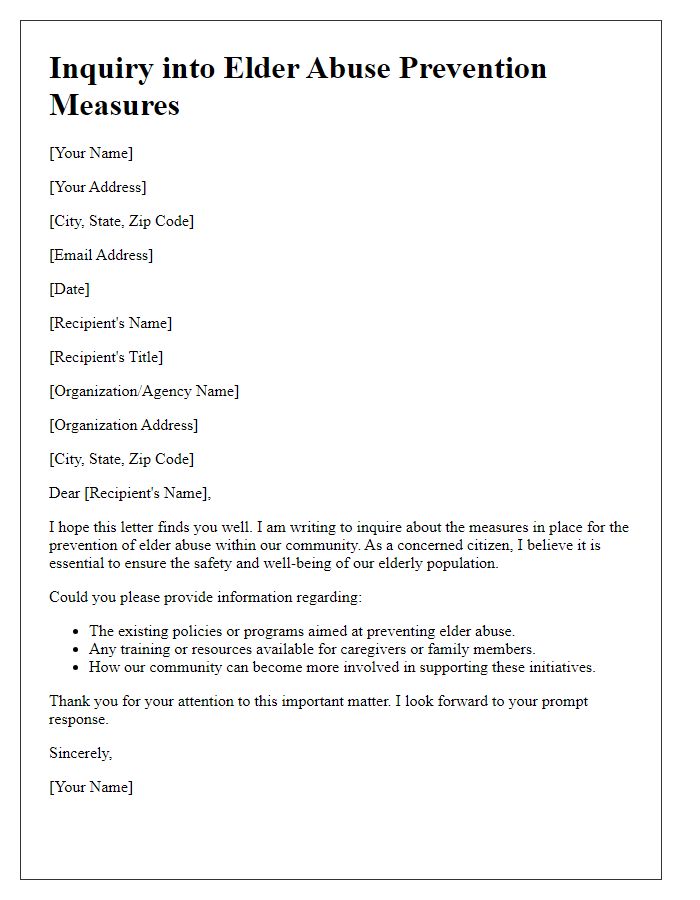When it comes to the sensitive issue of elder abuse, it's crucial to approach the topic with care and empathy. Many individuals might not realize the alarming frequency of abuse faced by our elderly loved ones, making it essential to raise awareness and foster open conversations about this pressing concern. By understanding the different forms of elder abuse, we can take proactive steps to prevent it and support those affected. Join me as we delve deeper into this important subject and explore ways to make a difference for our seniors.

Identification of Abuse Indicators
Elder abuse often manifests through various indicators that warrant careful attention. Unexplained injuries, such as bruises, fractures, or burns, frequently signal physical abuse. Behavioral changes, including withdrawal from social activities or sudden agitation, may indicate emotional abuse or neglect. Neglected personal hygiene, inadequate living conditions, or unexplained weight loss could reveal signs of elder neglect. Financial exploitation often presents as sudden changes in financial status, missing belongings, or lack of basic necessities despite adequate income. Additionally, the presence of fearful or anxious behavior around certain individuals may suggest abusive relationships. Identifying these indicators is crucial for ensuring the safety and well-being of older adults.
Legal and Ethical Obligations
Elder abuse represents a critical issue affecting vulnerable populations, particularly older adults over 65 years old, who may face physical, emotional, or financial harm. Legal frameworks, such as the Elder Justice Act enacted in 2010, reinforce obligations for reporting suspected abuse in care facilities, while state laws vary in their definitions and consequences of elder abuse. Ethical principles, such as beneficence and respect for autonomy, guide healthcare professionals in their duty to protect elderly individuals from harm. In 2022, a study by the WHO reported that approximately 1 in 6 older adults experienced some form of abuse in community settings, highlighting the urgent need for awareness and intervention. Reporting channels, such as Adult Protective Services (APS), serve as crucial resources in addressing abuse, ensuring the safety and dignity of elder adults. Legal consequences for abusers can include criminal charges, fines, and imprisonment, promoting accountability within society.
Resources for Support and Intervention
Elder abuse is a critical issue, affecting millions of seniors across the United States. According to the National Council on Aging, one in ten older adults experiences some form of elder abuse, which can occur in various settings, including nursing homes, assisted living facilities, and even within families. This abuse can take many forms, such as physical, emotional, financial, and neglect. Key resources for support include the Administration on Aging, which provides access to local services through the National Eldercare Locator, and the Elder Abuse Hotline, where trained professionals can offer guidance and assistance. Additionally, organizations like the National Center on Elder Abuse work to raise awareness and promote prevention strategies. Community resources such as local aging services and legal assistance programs can help victims regain control of their lives and ensure their safety.
Importance of Confidentiality and Privacy
Elder abuse remains a critical issue impacting thousands of vulnerable seniors in various communities across the globe, leading to physical, emotional, and financial harm. Reporting mechanisms for elderly abuse, including hotlines and local agencies, emphasize the significance of protecting the identity of victims to ensure their safety and encourage them to seek help without fear of repercussions. Confidentiality policies mandate that information shared by the elderly regarding abuse is kept secure within legal parameters, often involving caseworkers or legal representatives trained to handle delicate situations with dignity. Privacy measures extend to information handling practices, ensuring that sensitive details are disclosed only to authorized personnel to facilitate intervention and support services, enhancing overall trust within the reporting processes. In various jurisdictions, laws recognize the necessity of maintaining confidentiality, thereby balancing the need for intervention with the protection of seniors' personal rights and dignity.
Collaborative Approach with Authorities and Agencies
Elder abuse remains a critical issue affecting the well-being of vulnerable populations, particularly seniors aged 65 and older. It often manifests in various forms, including physical, emotional, financial, and neglectful abuse, frequently occurring in domestic settings or care facilities. Collaboration with local authorities, such as the Adult Protective Services (APS) and law enforcement agencies, is essential in addressing and preventing these heinous acts. Engaging healthcare providers and social service organizations plays a vital role in identifying signs of abuse, such as unexplained injuries, sudden changes in financial status, or withdrawal from social activities. Community outreach programs can raise awareness and provide education on recognizing and reporting elder abuse, fostering a more supportive environment for at-risk seniors. Establishing a multidisciplinary team approach allows for a comprehensive response, ensuring that victims receive immediate support, legal protection, and necessary healthcare services, thereby enhancing overall safety and quality of life.













Comments